Resistance of Concrete with Crystalline Hydrophilic Additives to Freeze–Thaw Cycles
Abstract
:1. Introduction
2. Experimental Part
2.1. Properties of Aggregates, Binders, and Additives to Concrete
2.2. Composition of Concrete Mixtures
2.3. Properties of Fresh and Hardened Concrete
3. Test Results
4. Discussion
5. Conclusions
Author Contributions
Funding
Institutional Review Board Statement
Informed Consent Statement
Data Availability Statement
Acknowledgments
Conflicts of Interest
References
- Surej, K.R. Evaluation and Improvement of Frost Durability of Clay Bricks—A Thesis in The Centre for Building Studies, Ottawa, Canada. 1997. Available online: https://www.collectionscanada.gc.ca/obj/s4/f2/dsk3/ftp04/nq25926.pdf (accessed on 12 December 2023).
- Pilehvar, S.; Szczotok, M.A.; Rodríguez, J.F.; Valentini, L.; Lanzón, M.; Pamies, R.; Kjøniksen, A.-L. Effect of freeze-thaw cycles on the mechanical behavior of geopolymer concrete and Portland cement concrete containing micro-encapsulated phase change materials. Constr. Build. Mater. 2019, 200, 94–103. [Google Scholar] [CrossRef]
- Richardson, G.M. Fundamentals of Durable Reinforced Concrete, 1st ed.; CRC Press: Boca Raton, FL, USA, 2002; pp. 51, 77, 101, 133, 160–179, 194. [Google Scholar]
- Qiu, Y.; Peng, H.; Zhao, H. Study on New Type of Concrete Air-Entraining Agent. In Proceedings of the International Conference on Artificial Intelligence and Electromechanical Automation (AIEA), Tianjin, China, 26–28 June 2020. [Google Scholar]
- Nowak-Michta, A. Impact analysis of air-entraining and superplasticizing admixtures on concrete compressive strength. Procedia Struct. Integr. 2019, 23, 77–82. [Google Scholar] [CrossRef]
- Nicula, L.M.; Corbu, O.; Iliescu, M. Influence of Blast Furnace Slag on the Durability Characteristic of Road Concrete Such as Freeze-Thaw Resistance. Procedia Manuf. 2020, 46, 194–201. [Google Scholar] [CrossRef]
- Islam, M.M.; Alam, M.T.; Islam, M.S. Effect of fly ash on freeze–thaw durability of concrete in marine environment. Aust. J. Struct. Eng. 2018, 19, 146–161. [Google Scholar] [CrossRef]
- Zang, P.; Li, Q.-F. Freezing–thawing durability of fly ash concrete composites containing silica fume and polypropylene fiber. Proc. Inst. Mech. Eng. Part L J. Mater. Des. Appl. 2013, 228, 241–246. [Google Scholar] [CrossRef]
- Li, X.; Ling, T.C.; Mo, K.H. Functions and impacts of plastic/rubber wastes as eco-friendly aggregate in concrete—A review. Constr. Build. Mater. 2020, 240, 117869. [Google Scholar] [CrossRef]
- Kumar, R.; Dev, N. Effect of acids and freeze-thaw on durability of modified rubberized concrete with optimum rubber crumb content. J. Appl. Polym. Sci. 2022, 139, 52191. [Google Scholar] [CrossRef]
- He, Y.; Xu, F.; Wei, H. Effect of Particle Size on Properties of Concrete with Rubber Crumbs. Am. J. Civ. Eng. 2022, 10, 79–87. [Google Scholar] [CrossRef]
- Pham, N.P.; Toumi, A.; Turatsinze, A. Effect of an enhanced rubber-cement matrix interface on freeze-thaw resistance of the cement-based composite. Constr. Build. Mater. 2019, 207, 528–534. [Google Scholar] [CrossRef]
- Ribeiro, M.S.C.; Juvandes, L.F.P.; Rodrigues, J.D.; Ferreira, A.; Marques, A.T. Behaviour of Cement and Polymer Mortar Materials to Rapid Freeze-Thaw Cycling. Mater. Sci. Forum 2010, 636–637, 1329–1335. [Google Scholar] [CrossRef]
- Khashayar, J.; Heidarnezhad, F.; Moammer, O.; Jarrah, M. Experimental investigation on freeze—Thaw durability of polymer concrete. Front. Struct. Civ. Eng. 2021, 15, 1038–1046. [Google Scholar] [CrossRef]
- Qu, Z.; Guo, S.; Sproncken, C.C.M.; Surís-Valls, R.; Yu, Q.; Voets, I.K. Enhancing the Freeze–Thaw Durability of Concrete through Ice Recrystallization Inhibition by Poly(vinyl alcohol). ACS Omega 2020, 5, 12825–12831. [Google Scholar] [CrossRef] [PubMed]
- Guo, Y.; Shen, A.; Sun, X. Exploring Polymer-Modified Concrete and Cementitious Coating with High-Durability for Roadside Structures in Xinjiang, China. Adv. Mater. Sci. Eng. 2017, 2017, 9425361. [Google Scholar] [CrossRef]
- Hammodat, W.W. Investigate road performance using polymer modified concrete. Mater. Today Proc. 2021, 42, 2089–2094. [Google Scholar] [CrossRef]
- Saeed, H. Properties of polymer impregnated concrete spacers. Case Stud. Constr. Mater. 2021, 15, e00772. [Google Scholar] [CrossRef]
- Caiyun, W.; Li, W.; Zhang, C.; Jinpeng, F. Effect of Protective Coatings on Frost Resistance of Concrete Structures in Northeast Coastal Areas. IOP Conf. Ser. Mater. Sci. Eng. 2019, 678, 012108. [Google Scholar] [CrossRef]
- Liu, T.; Zhang, C.; Zhou, K.; Tian, Y. Freeze-thaw cycling damage evolution of additive cement mortar. Eur. J. Environ. Civ. Eng. 2021, 25, 2089–2110. [Google Scholar] [CrossRef]
- Setzer, M.J.; Fagerlund, G.; Janssen, D.J. CDF test—Test Method for the Freeze-Thaw Resistance of Concrete-Tests with Sodium Chloride Solution (CDF). Mater. Struct. 1996, 29, 523–528. [Google Scholar] [CrossRef]
- Matar, M.G.; Aday, A.N.; Srubar III, W.V. Surfactant properties of a biomimetic antifreeze polymer admixture for improved freeze-thaw durability of concrete. Constr. Build. Mater. 2021, 313, 125423. [Google Scholar] [CrossRef]
- Ji, Y.; Zou, Y.; Ma, Y.; Wang, H.; Li, W.; Xu, X. Frost Resistance Investigation of Fiber-Doped Cementitious Composites. Materials 2022, 15, 2226. [Google Scholar] [CrossRef]
- Stefanidou, M.; Kamperidou, K.; Konstandinidis, A.; Koltsou, P.; Papadopoulos, S. Rheological properties of biofibers in cementitious composite matrix. In Advances in Bio-Based Fibre; Elsevier: Amsterdam, The Netherlands, 2022; pp. 553–573. [Google Scholar] [CrossRef]
- Oliveira, A.S.; Toledo Filho, R.D.; Rego Fairbairn, E.M.; Cappa de Oliveira, L.F.; Martins Gomes, O.F. Microstructural characterization of self-healing products in cementitious systems containing crystalline admixture in the short- and long-term. Cem. Concr. Compos. 2022, 126, 104369. [Google Scholar] [CrossRef]
- García Calvo, J.L.; Sánchez Moreno, M.; Carballosa, P.; Pedrosa, F.; Tavares, F. Improvement of the Concrete Permeability by Using Hydrophilic Blended Additive. Materials 2019, 12, 2384. [Google Scholar] [CrossRef] [PubMed]
- Park, B.; Choi, Y.C. Effect of healing products on the self-healing performance of cementitious materials with crystalline admixtures. Constr. Build. Mater. 2021, 270, 121389. [Google Scholar] [CrossRef]
- Roig-Flores, M.; Moscato, S.; Serna, P.; Ferrara, L. Self-healing capability of concrete with crystalline admixtures in different environments. Constr. Build. Mater. 2015, 86, 1–11. [Google Scholar] [CrossRef]
- Escoffres, P.; Desmettre, C.; Charron, J.P. Effect of a crystalline admixture on the self-healing capability of high-performance fiber reinforced concretes in service conditions. Constr. Build. Mater. 2018, 173, 763–774. [Google Scholar] [CrossRef]
- Reddy, T.C.S.; Ravitheja, A. Macro mechanical properties of self-healing concrete with crystalline admixture under different environments. Ain Shams Eng. J. 2019, 10, 23–32. [Google Scholar] [CrossRef]
- Zhang, C.; Lu, R.; Li, Y.; Guan, X. Effect of crystalline admixtures on mechanical, self-healing and transport properties of engineered cementitious composite. Cem. Concr. Compos. 2021, 124, 104256. [Google Scholar] [CrossRef]
- Gojević, A.; Ducman, V.; Netinger Grubeša, I.; Baričević, A.; Banjad Pečur, I. The Effect of Crystalline Waterproofing Admix-tures on the Self-Healing and Permeability of Concrete. Materials 2021, 14, 1860. [Google Scholar] [CrossRef]
- Lauch, K.S.; Desmettre, C.; Charron, J.P. Self-healing of concrete containing different admixtures under laboratory and long-term real outdoor expositions based on water permeability test. Constr. Build. Mater. 2022, 324, 126700. [Google Scholar] [CrossRef]
- CEN/TS 12390-9:2016; Testing Hardened Concrete—Part 9: Freeze-Thaw Resistance—Scaling. CEN: Brussels, Belgium, 2016.
- CEN/TR 15177:2006; Testing the Freeze-Thaw Resistance of Concrete—Internal Structural Damage. CEN: Brussels, Belgium, 2006.
- EN 480-11:2005; Admixtures for Concrete, Mortar and Grout—Test Methods—Part 11: Determination of Air Void Characteristics in Hardened Concrete (EN 480-11:2005). CEN: Brussels, Belgium, 2005.
- Elsalamawy, M.; Mohamed, A.R.; Abdel-latif, E.A. Performance of crystalline forming additive materials in concrete. Constr. Build. Mater. 2020, 230, 117056. [Google Scholar] [CrossRef]
- EN 1097-6:2013; Tests for Mechanical and Physical Properties of Aggregates—Part 6: Determination of Particle Density and Water Absorption. CEN: Brussels, Belgium, 2013.
- ISO 9277:2022; Determination of the Specific Surface Area of Solids by Gas Adsorption BET Meth. International Organization for Standardization: Geneva, Switzerland, 2022.
- EN 196-6:2019; Methods of Testing Cement—Part 6: Determination of Fineness. CEN: Brussels, Belgium, 2019.
- EN 12350-2:2019; Testing Fresh Concrete—Part 2: Slump-Test. CEN: Brussels, Belgium, 2019.
- EN 12350-6:2019; Testing Fresh Concrete—Part 6: Density. CEN: Brussels, Belgium, 2019.
- EN 12350-7:2019; Testing Fresh Concrete—Part 7: Air Content—Pressure Methods. CEN: Brussels, Belgium, 2019.
- EN 206:2021; Concrete—Specification, Performance, Production and Conformity (EN 206:2013+A2:2021). CEN: Brussels, Belgium, 2021.
- Lin, X.; Li, W.; Castel, A.; Kim, T.; Huang, Y.; Wang, K. A comprehensive review on self-healing cementitious composites with crystalline admixtures: Design, performance and application. Constr. Build. Mater. 2023, 409, 134108. [Google Scholar] [CrossRef]
- Shetiya, R.K.; Elhadad, S.; Salem, A.; Fülöp, A.; Orban, Z. Investigation into the Effects of Crystalline Admixtures and Coatings on the Properties of Self-Healing Concrete. Materials 2024, 17, 767. [Google Scholar] [CrossRef]
- EN 12390-3; Testing Hardened Concrete—Part 3: Compressive Strength of Test Specimens. CEN: Brussels, Belgium, 2019.
- Cappellesso, V.G.; Petry, N.D.S.; Molin, D.C.C.D.; Masuero, A.B. Use of crystalline waterproofing to reduce capillary porosity in concrete. J. Build. Pathol. Rehabil. 2016, 1, 9. [Google Scholar] [CrossRef]
- García-Vera, V.E.; Tenza-Abril, A.J.; Saval, J.M.; Lanzón, M. Influence of Crystalline Admixtures on the Short-Term Behaviour of Mortars Exposed to Sulphuric Acid. Materials 2019, 12, 82. [Google Scholar] [CrossRef] [PubMed]
- Zha, Y.; Yu, J.; Wang, R.; He, P.; Cao, Z. Effect of ion chelating agent on self-healing performance of Cement-based materials. Constr. Build. Mater. 2018, 190, 308–316. [Google Scholar] [CrossRef]
- Manhanga, F.C.; Rudžionis, Ž.; Ivanauskas, E.; Augonis, A. The investigations on properties of self-healing concrete with crystalline admixture and recycled concrete waste. MATEC Web Conf. 2022, 364, 05002. [Google Scholar] [CrossRef]
- Zhu, Y.; Yang, Y.; Yao, Y. Autogenous self-healing of engineered cementitious composites under freeze–thaw cycles. Constr. Build. Mater. 2012, 34, 522–530. [Google Scholar] [CrossRef]
- Wu, H.; Zhao, Y.; Chen, X.; Li, S.; Zhao, Y. Effect of crystalline admixture and superabsorbent polymer on the self-healing and mechanical properties of basalt fibre mortars. J. Asian Archit. Build. Eng. 2023. [Google Scholar] [CrossRef]
- Wang, R.; Hu, Z.; Li, Y.; Wang, K.; Zhang, H. Review on the deterioration and approaches to enhance the durability of concrete in the freeze–thaw environment. Constr. Build. Mater. 2022, 321, 126371. [Google Scholar] [CrossRef]
- Ferrara, L.; Krelani, V.; Carsana, M. A “fracture testing” based approach to assess crack healing of concrete with and without crystalline admixtures. Constr. Build. Mater. 2014, 68, 535–551. [Google Scholar] [CrossRef]
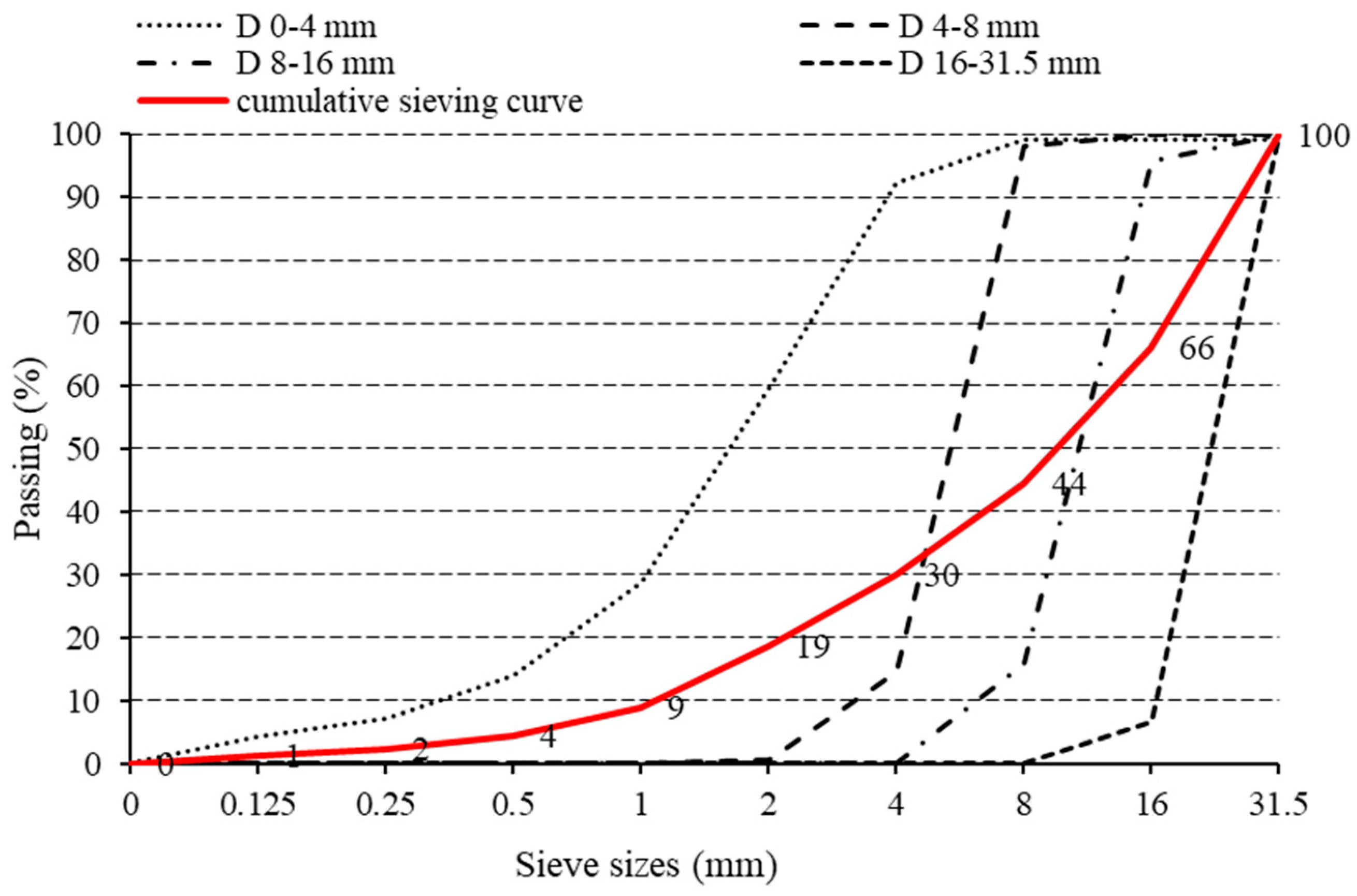

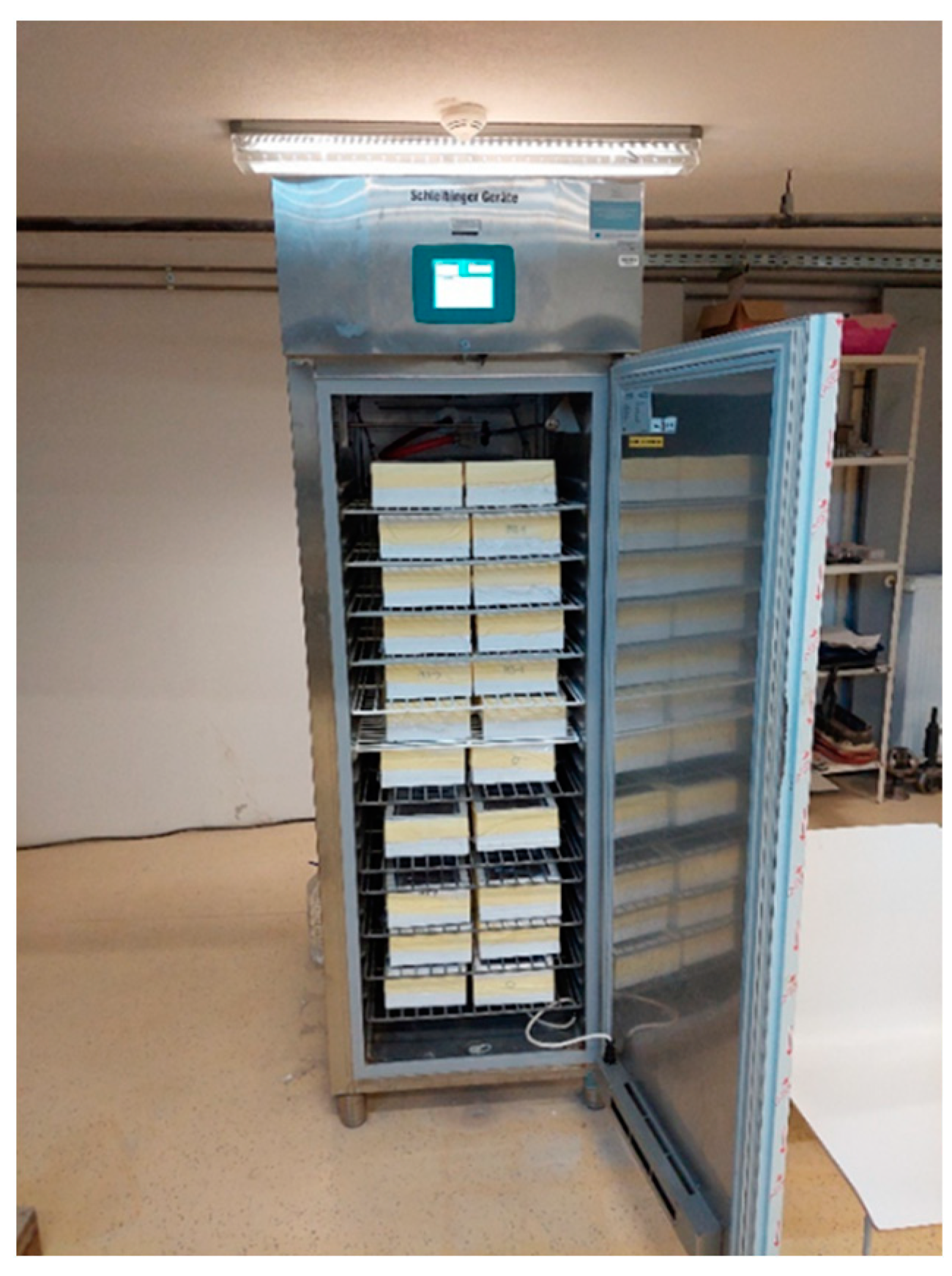
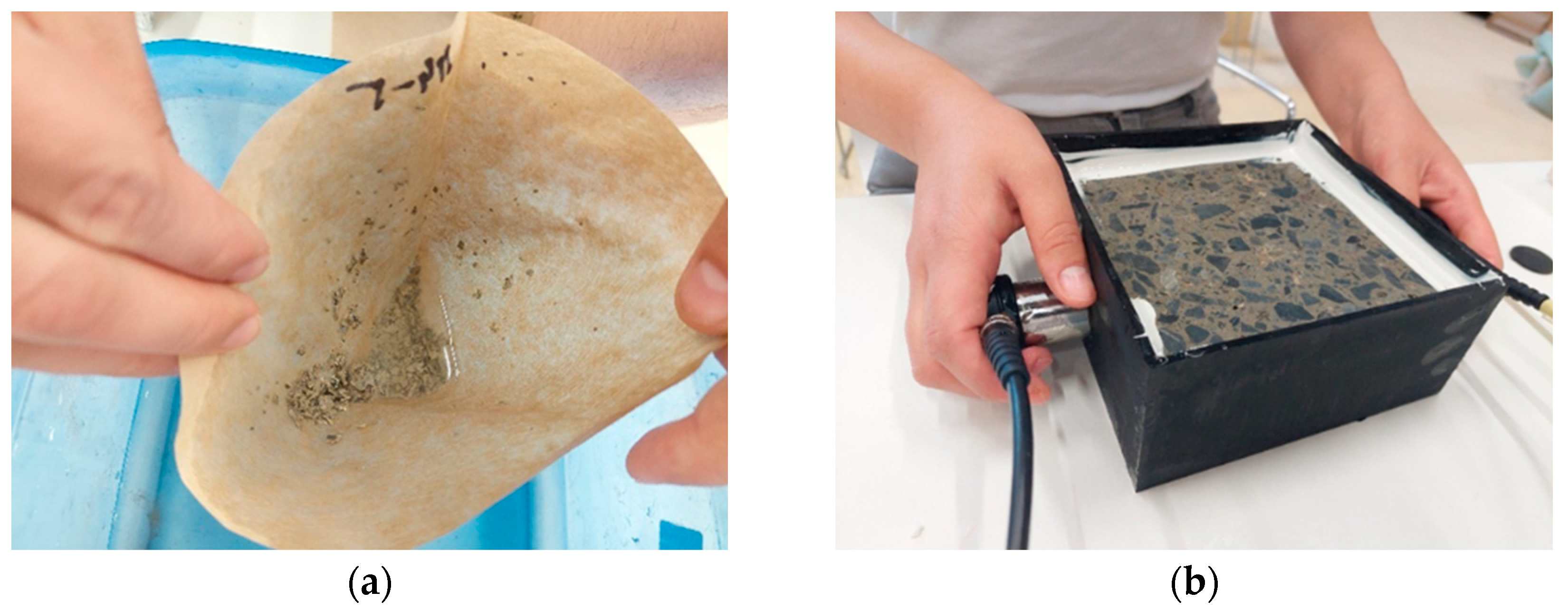
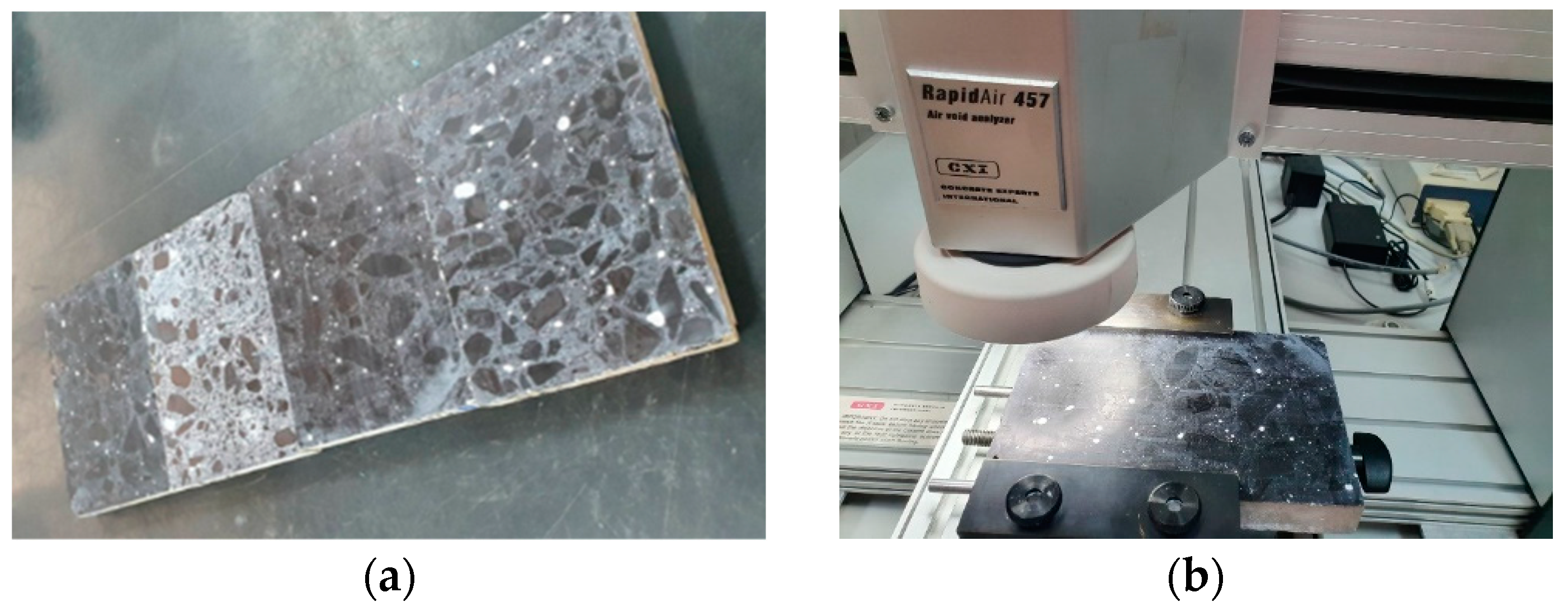

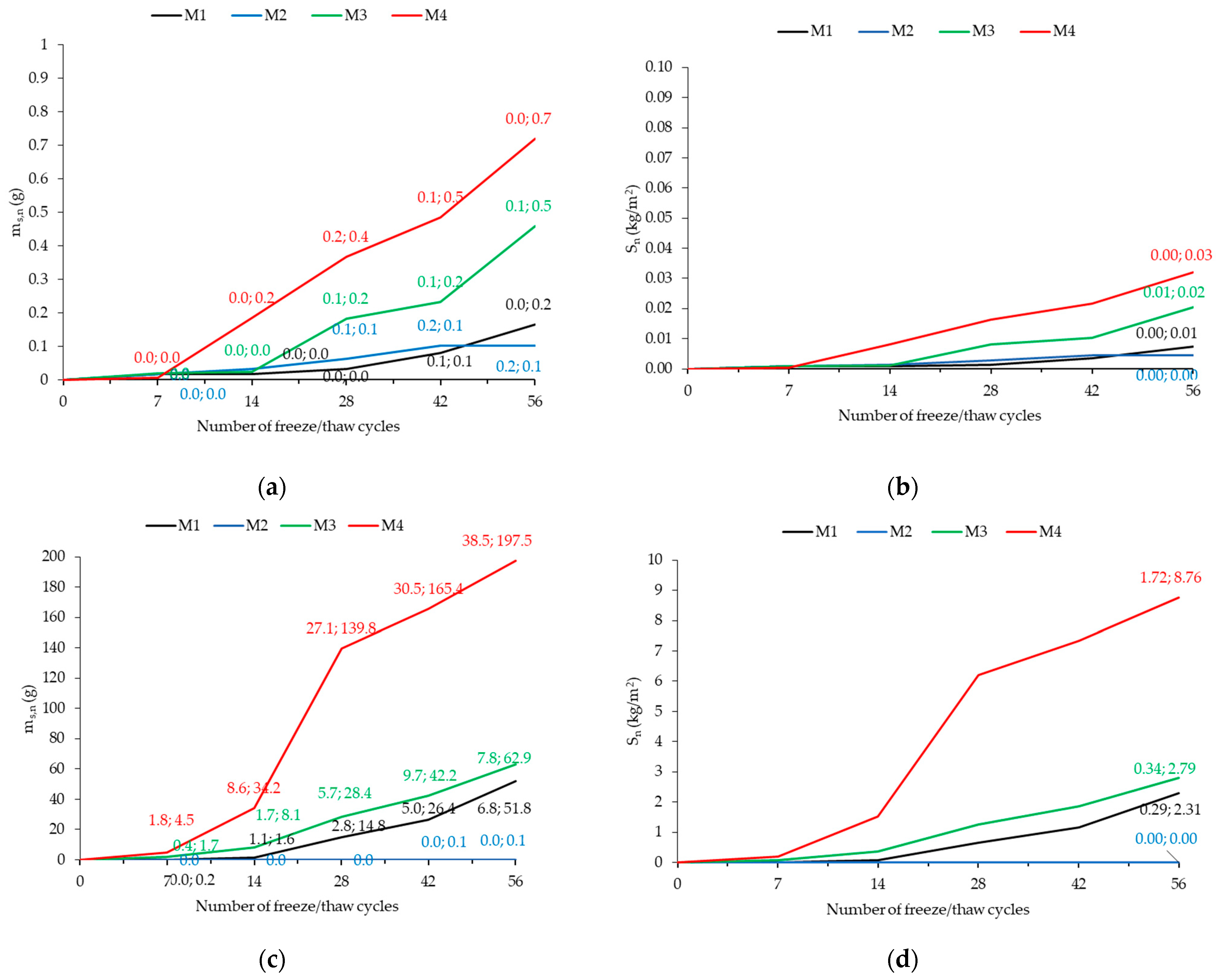

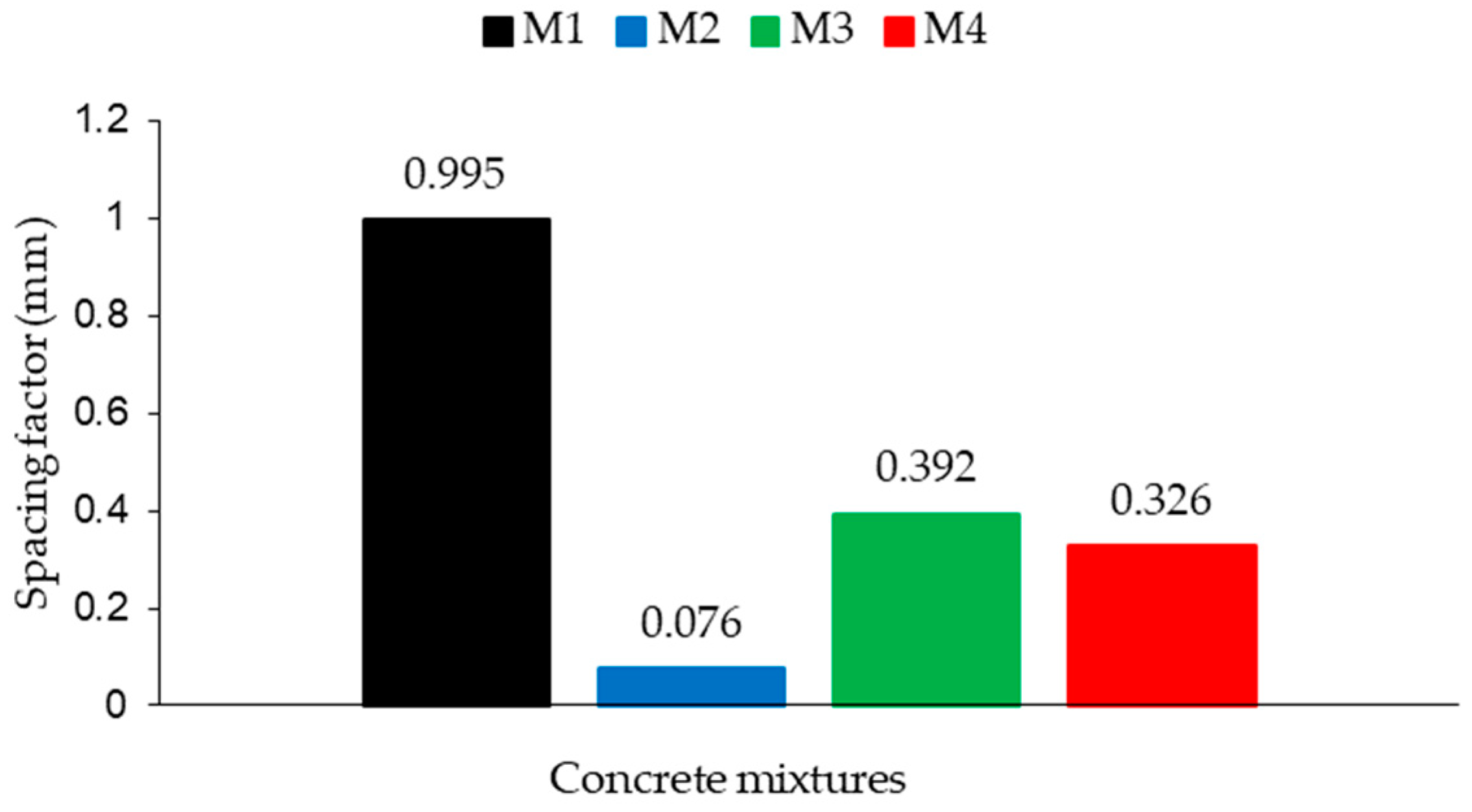

| Components | Density, kg/m3 | Specific Surface Area, m2/g |
|---|---|---|
| Cement, CEM I 52.5 N | 2960 | 3.76 |
| Superplasticiser, ViscoCrete 5380 | 1080 | - |
| Air entraining agent, LPS A 94 | 1000 | - |
| Crystalline hydrophilic admixture (CA), Penetron | 2910 | 2.70 |
| Mixture/Components | M1 | M2 | M3 | M4 | |
|---|---|---|---|---|---|
| Cement (kg) | 400 | 400 | 396 | 388 | |
| Water (kg) | 140 | 140 | 140 | 140 | |
| Superplasticizer (kg) | 4 | 4 | 4 | 4 | |
| Air entraining agent (kg) | - | 0.8 | - | - | |
| Crystalline hydrophilic admixture (kg) | - | - | 4 | 12 | |
| Aggregate | Dolomite 0–4 mm (kg) | 576.6 | 576.6 | 576.6 | 576.6 |
| Dolomite 4–8 mm (kg) | 195.6 | 195.6 | 195.6 | 195.6 | |
| Dolomite 8–16 mm (kg) | 469.8 | 469.8 | 469.8 | 469.8 | |
| Dolomite 16–31.5 mm (kg) | 685 | 685 | 685 | 685 | |
| Filler (kg) | 30.2 | 30.2 | 30.2 | 30.2 | |
| Mixture | M1 | M2 | M3 | M4 |
|---|---|---|---|---|
| Consistency–slump (cm) | 12 | 14 | 11 | 11 |
| Density (kg/m3) | 2504 | 2439 | 2520 | 2489 |
| Air content (%) | 1.5 | 5 | 1.5 | 1.6 |
Disclaimer/Publisher’s Note: The statements, opinions and data contained in all publications are solely those of the individual author(s) and contributor(s) and not of MDPI and/or the editor(s). MDPI and/or the editor(s) disclaim responsibility for any injury to people or property resulting from any ideas, methods, instructions or products referred to in the content. |
© 2024 by the authors. Licensee MDPI, Basel, Switzerland. This article is an open access article distributed under the terms and conditions of the Creative Commons Attribution (CC BY) license (https://creativecommons.org/licenses/by/4.0/).
Share and Cite
Gojević, A.; Netinger Grubeša, I.; Juradin, S.; Banjad Pečur, I. Resistance of Concrete with Crystalline Hydrophilic Additives to Freeze–Thaw Cycles. Appl. Sci. 2024, 14, 2303. https://doi.org/10.3390/app14062303
Gojević A, Netinger Grubeša I, Juradin S, Banjad Pečur I. Resistance of Concrete with Crystalline Hydrophilic Additives to Freeze–Thaw Cycles. Applied Sciences. 2024; 14(6):2303. https://doi.org/10.3390/app14062303
Chicago/Turabian StyleGojević, Anita, Ivanka Netinger Grubeša, Sandra Juradin, and Ivana Banjad Pečur. 2024. "Resistance of Concrete with Crystalline Hydrophilic Additives to Freeze–Thaw Cycles" Applied Sciences 14, no. 6: 2303. https://doi.org/10.3390/app14062303






